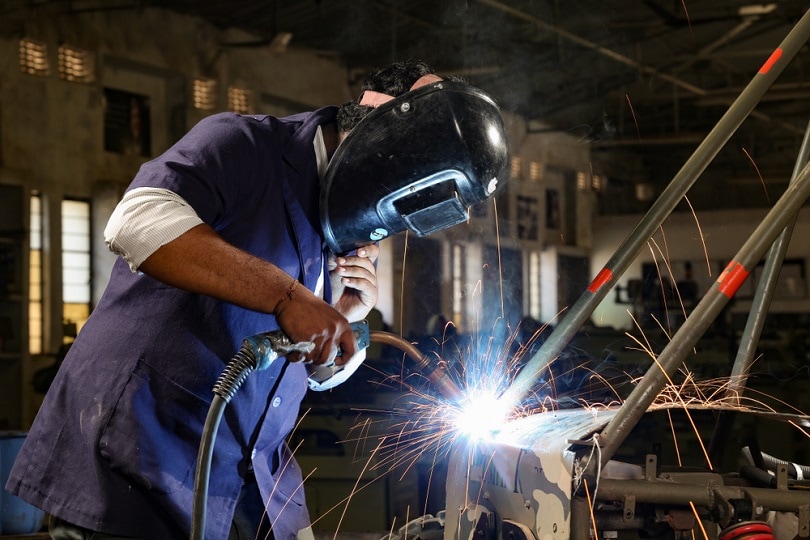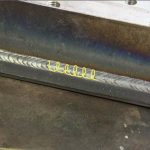Welding is a skill that requires time, effort, and understanding.
Is welding hard? For some people it can be more difficult than for others due to the intricacies of the process.
We’ll look at why welding can be so challenging in this blog post!
Is welding hard?
Contents
- 1 Is welding hard?
- 2 What Factors Determine How Hard Welding Is?
- 3 What is Welding?
- 4 How Hard Is Welding School?
- 5 Common Types of Welding
- 6 How to Learn Welding Fast
- 7 What To Look For In A Good Welding School
- 8 How to Learn Welding Correctly With Your time
- 9 How Long Does It Take to Learn the Welding?
- 10 Conclusion
It’s a common question, and it’s easy to understand why.
Welding is an intimidating process that requires complicated equipment and skills.
Is welding difficult? Is welding right for you? If these are the questions going through your mind right now, then read on!
Welding may be challenging at first – but once you figure out the basics, you’ll be well on your way to a successful welding career.
What Factors Determine How Hard Welding Is?
There are a variety of factors that determine how hard welding is.
First, the materials being welded play an important role in determining difficulty levels.
For example, welding aluminum is much harder than welding steel because aluminum melts at such a high temperature and does not conduct heat well (steel conducts heat better).
Second, knowing what tools to use for each welding procedure.
For welding, it is important to use the right welding mask and welding gloves because they provide protection against ultraviolet light and extreme heat.
Finally, a good welder must be smart about safety when conducting welding procedures as well as having excellent teaching skills in order to develop patience with themselves and students during practice sessions.
In addition, welding takes time for practical application in order to achieve the best welds possible.
welding is not a difficult task, but it does take some skill and knowledge to do it correctly. With the right tools, safety precautions, and patience, anyone can learn how to weld like a pro!
What is Welding?
There are many different welding techniques but the most common is generally called “gas welding”.
In gas welding, a strong flame heats up two metal objects to their melting point and then they are joined together permanently by means of pressure or filler material.
Sometimes, certain metals can be welded with just heat without using any other methods such as welding rods.
This is called “resistance welding” and it uses an electrical current to heat up the metal until it melts, then fuses together.
There are many different types of welding such as arc welding, spot welding and MIG welding (metal inert gas).
Different welders use different techniques depending on what welding rods they are using and the type of metals that need to be joined.
Welders can also use heat sources such as gas torches or laser beams instead of flames, but the principle is still the same with all welding techniques: heating up two metal objects to their melting point in order for them to fuse together when cooled down.
How Hard Is Welding School?
It is not an easy welding school, but it is by no means impossible to succeed in.
It requires a significant amount of study and practice to become good at welding.
Some people do struggle with welding for various reasons such as:
- Lack of interest or motivation
- Difficulties learning some welding techniques
- Failure to pass exams due to poor welding test results
Welding is a challenging activity that takes time and effort to perfect, but it can be an extremely rewarding profession.
Those who are successful in welding school have usually put in the hard work necessary to learn the craft.
There are many different welding schools across the country, so it is important to do your research before choosing one.
The best way to find out how hard welding school is, is to ask people who have already gone through it.
Welding can be a difficult process to learn, but with the right instruction and practice, anyone can do it.
There are many different welding schools across the country, so make sure you do your research before choosing one.
The best way to find out how welding school is, is to ask people who have already gone through it.
Common Types of Welding
There are many welding processes available for different tasks.
Some of the common welding types are:
- Tungsten Inert Gas Welding (used on automobiles)
- Stick welding (for large repairs)
- Wire welding (minimize welding interruptions)
There are more welding methods to name, but these three cover most applications in welding.
Each welding process has its own benefits and drawbacks, so it is important to know which one to use for the task at hand.
Welding can be a difficult skill to learn, but with practice anyone can do it! So get out there and weld away!
How to Learn Welding Fast
If you do not have welding experience, it can be hard to get a welding job.
However, there are ways you can learn welding fast and become a welder quickly!
As soon as possible, try getting some welding training or apprenticeship so that you will know how the equipment works in the shop.
When applying for jobs at places that weld frequently, emphasize your welding experience and skills in your resume.
If you are already working at a job that does not involve welding, see if there is an opportunity to be transferred to a welding position.
Welders have many employment opportunities available to them.
Some of these include: metal and plastic machine workers, steamfitters, pipefitters, and plumbers, sheet metal workers, boilermakers, assemblers and fabricators.
Welding is a great skill to have that offers many opportunities for job security and career growth.
With the right welding training, you can learn welding fast and be on your way to an exciting welding career!
Welders are in high demand and can be paid well.
What To Look For In A Good Welding School
In welding, there are plenty of welding schools to choose from.
It is important that you find the right one for your needs.
A good welding school will teach you all the basics of welding.
You’ll learn about metallurgy, how to cut metal, and welding quality control.
In addition, you’ll also learn a variety of welding procedures.
With a welding school, you’ll be able to weld in a variety of locations.
You can even weld plates and pipes at the same time.
Welding is a challenging trade, but it’s also very rewarding.
Be sure to consider all your options before making a decision.
How to Learn Welding Correctly With Your time
You can’t be taught welding in a day, welding is not an easy skill to learn. It takes time and effort before you are able to master the technique of welding metal together.
Here are some ideas for making your learning process easier:
- Be prepared for it to take awhile
- Practice as much as you can every chance that presents itself- any way that you can put yourself to the test welding will make you better
- Get a good night’s sleep so that your mind and body are both fresh for welding the next day.
In welding, as in most things, failure is an important step on the way to success.
The more you weld, the better you’ll become, but don’t be discouraged if welding doesn’t come easy to you at first- it takes many welders years to become truly skilled.
With dedication and hard work, you can be a successful welder too.
Welding is not an easy skill to learn but with the right approach, time and effort you will get there.
Just make sure that you practice as much as possible.
How Long Does It Take to Learn the Welding?
If you want to learn the welding well, you need to set some time limit for yourself.
People typically give themselves a time limit of three to four weeks.
It will take more or less time depending on your welding level.
If you have never welded before, it may take six to eight months to complete all the welding lessons and become a qualified welder.
However, if you are an experienced welder, you may only need one to two weeks.
It is contingent upon where one begins.
You have less than a year to learn all of the skills necessary to become a qualified welder.
If welding interests you, then take welding classes and enjoy your time learning welding!
Conclusion
Welding is a rewarding and steady profession, with an industry expected to grow at rapid rates.
But there are also many different paths for advancement available in the welding field.
The range of possibilities makes it easier than ever to find what’s right for you!





